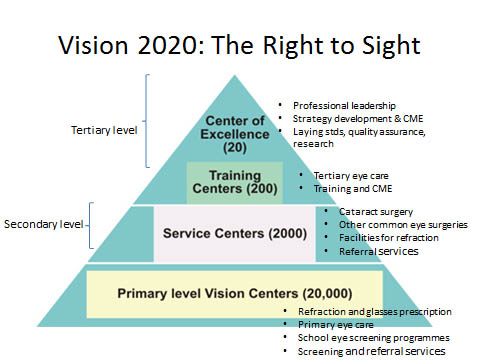
Lecture available on: http://www.ihatepsm.com/resource/blindness
Definition of Blindness: WHO 2011
“Visual acuity of less than 3/60 (Snellen’s chart) or its equivalent”
Equivalent of < 3/60: Inability to count fingers in daylight at a distance of 3 meters
(3/60 is practically equivalent to counting fingers in daylight at a distance of 3 meters)
(Similarly, 1/60 is practically equivalent to counting fingers in daylight at a distance of 1 meters)
Leads to:
- Reduced economic and social status
- Even premature death (lower LE observed)

Indian Definition of Blindness
• Though, For International comparison, WHO has defined blindness at the level of 3/60 or inability to count fingers at a distance of 3 meters or 10 feet
• In India, under NPCB, Blindness is defined at a higher cut off, as given below:
– Simple Definition: Inability of a person to count fingers from a distance of 6 meters or 20 feet
– Technical Definition: Vision 6/60 or less with the best possible spectacle correction
Problem Statement
World
(2010), 90% of the blind in the world are living in developing countries.
• 80% blindness is avoidable (treatable/preventable)
• 82% of visually impaired are 50yr or older (o/w 20% of population) *(increasing population of the elderly will make this a priority)
• Most visually impaired children are so due to refractory errors – easily correctable
Overall, visual impairment decreased since 1990’s due to public health action (control of infectious diseases leading to visual impairment)
India
• Estimated prevalence of blindness in 2004, 11.2 per 1000 population (men-10.2, women- 12.2 per 1000 )
• 2006-7 rapid National Survey:
– Prevalence reduced from 1.1% to 1.0% and
– estimated national prevalence of childhood blindness/low vision was 0.8 / 1000

Major causes (world)
• Cataract-33%,
• Glaucoma-2%,
• Uncorrected refractive errors-43%
• No. of visually impaired from infectious diseases greatly reduced in last 20 years
Causes – Developed Countries
• Accidents
• Glaucoma
• DM
• Vascular diseases like HT
• Cataract
• Degeneration of ocular tissues esp. retina
• Hereditary conditions
Causes – SEAR
• Cataract – 50-80%
• Uncorrected refractive errors
• Vitamin A def. used to be a major cause in childhood now declining
• Emerging causes – glaucoma, age related macular degeneration, diabetic retinopathy, corneal ulcer and ocular trauma
• Corneal opacity: now less due to Xerophthalmia and trachoma but increasingly due to:
– Trauma
– Corneal ulcer
Causes of Blindness – India
National survey on blindness 2006-7
• Cataract 62.6%
Senile cataract a decade earlier than Europe and America
• Uncorrected refractive errors 19.7%
• Glaucoma 5.8%
• Posterior segment pathology 4.7%
• Others: injuries (esp. in cottage industry), congenital, retinal det, tumours, HT, DM, leprosy etc.
Epidemiological Determinants (Risk Factors)
• Age: 30% blinds lose sight < 20yr age
Younger age group causes are:
Refractive error
Trachoma
Conjunctivitis
Malnutrition (vitamin A deficiency)
Middle age:
Cataract
Refractive error
Glaucoma
DM
• Sex: higher prevalence of blindness in females
Higher prevalence of trachoma, conjunctivitis and cataract among females
• Malnutrition
Vit A def, measles and diarrhoea ppt malnutrition, PEM are associated with vitamin A def
Limited to first 4-6 yr of life, esp in 6mth-3yr of life
• Occupation- Certain factories and cottage industries like
welding, stone crushing, chiselling, x-rays, UV rays etc.
• Social class- twice more prevalent in poorer classes
• Social factors
Quacks,
ignorance,
poverty,
low standard of hygiene,
inadequate health services
Blindness Control
Blindness is a significant burden to society:
• Cost of lost productivity and
• That of rehabilitation and education of the blind are very high.
• Swift and effective use of resources for the prevention of such blindness is only a small fraction.
• Hence cost effective in terms of the resources and human suffering avoided
Changing concepts
Emphasis on comprehensive eye-health care for control of avoidable blindness
instead of on management by clinical ophthalmologist alone
Comprehensive eye-health care includes the following concepts:
• Primary eye care
Inclusion of eye care in primary health care system-promotion, prevention and Mx of common eye diseases
• Epidemiological approach
Measurement of incidence, prevalence, RF’s etc.
Action based on these
• Team approach
Involvement of auxiliary health workers like ANM, MPW, ASHA etc.
• Establishment of national programmes
Initially for trachoma, later NPCB
Concept of “Avoidable Blindness”
A major portion of blindness in developing countries can be either:
• Cured or
Cataract
• Could have been prevented
Malnutrition leading to Vitamin A def.: PEM, Measles, diarrhoea, ARI
Trachoma and its complications- face washing, antibiotic ointment, and corrective lid surgery
The general lack of eye health services in certain underserved communities in developing countries is responsible for this ‘Avoidable blindness”.
• Early treatment of infectious and nutritional eye disease is essential to prevent visual loss. Such treatment can often be delivered effectively by peripheral health worker level itself.
Causes of Childhood Blindness (< 16 Yr.) – SEAR
• Xerophthalmia (Now reduced considerably)
• Congenital cataract
• Congenital glaucoma
• optic atrophy due to meningitis
• Retinopathy of prematurity
• Uncorrected refractive errors
Prevention and Control of “Avoidable Blindness”
• Initial assessment
Setting priorities and setting up appropriate measures
• Intervention
Primary care
Secondary care
Tertiary care
• Specific programmes
Trachoma control programme in 1963
School health services
Vitamin A prophylaxis
Occupational eye health services
• Long term measures
Improving quality of life
Improving
Sanitation
Water supply
Intake of foods rich in vitamin A, etc.
• Evaluation
Interventions
Intervention
Primary care
Secondary care
Tertiary care
Conditions to be recognized and managed by primary health care worker
• Acute conjunctivitis
• Ophthalmia neonatorum
• Trachoma, Trichiasis, Entropion
• Sub-conjunctival haemorrhages
• Conjunctival foreign bodies- removal
• Corneal foreign body- remove, refer
• Night blindness & Bitot spot –
Vit A, orally,
2lakh units,
on two consecutive days
• Lid lesions like
Stye
Chalazia
• Allergic conjunctivitis
• Etc.
Basic Drugs Supply for Primary Eye Care
• Tetracycline 1% ointment
• Topical antimicrobial like chloremphenicol’
• Zinc sulphate 0.2% eye drops
• Vitamin A capsules (2 lakh units)
• Silver nitrate 1% eye drops for prophylaxis in neonates
Conditions to be Recognized and Referred To Secondary Eye Care Level
• Corneal ulcers
Red, painful eye
Reduced vision
Intense watering of eye
Frequently result in corneal opacity if not treated in time.
• Perforation of eye ball
• Lid lacerations
• Entropion
• Trichiasis
• Cataract
• Pterygium
• Visual loss
• Burns including chemical burns
• Lid lacerations
• etc
Definitive management of common blinding conditions:
Cataract
Trichiasis
Entropion
Ocular trauma
Glaucoma etc.
• Provided by PHCs and district hospitals if eye clinics established there
• Also by mobile eye clinics (eye camps)-
Cataract operations as it is the major cause of blindness
Conduction of surveys
Require community participation
Effective use of resources as problem specific
Adequate follow up and evaluation must
Useful but lack permanence
Tertiary Level Eye Care
• Regional capitals and often associated with medical colleges and medical institutes
• Provide sophisticated surgeries
Retinal detachment
Corneal grafting, etc.
• Establishment of eye banks-corneal grafting acts
• Rehabilitation- special schools for the blind
National institute for the blind in Dehradun
National and International Agencies
A. The National Association for the Blind (NAB)
– Voluntary organization
– Provides welfare services to the blind throughout the country
B. Royal Commonwealth Society for the Blind
A + B: International Agency for the Prevention of Blindness (invited by the WHO to do so)
– Main area of work is prevention of blindness
– Exchange workers, plans, enrich programs among neighboring countries
Vision 2020: Right to Sight
• Global initiative
• By WHO
• On 18th Feb, 1999
• Aim to eliminate ‘Avoidable Blindness’
• Recognition of sight as a fundamental human right by all countries
• Eliminate blindness due to:
– Cataract
– Xerophthalmia and other causes of childhood blindness
– Refractive error and low vision
– Trachoma and
– Other causes of corneal blindness
• By 2020
Lecture on Blindness available at: http://www.ihatepsm.com/resource/blindness
